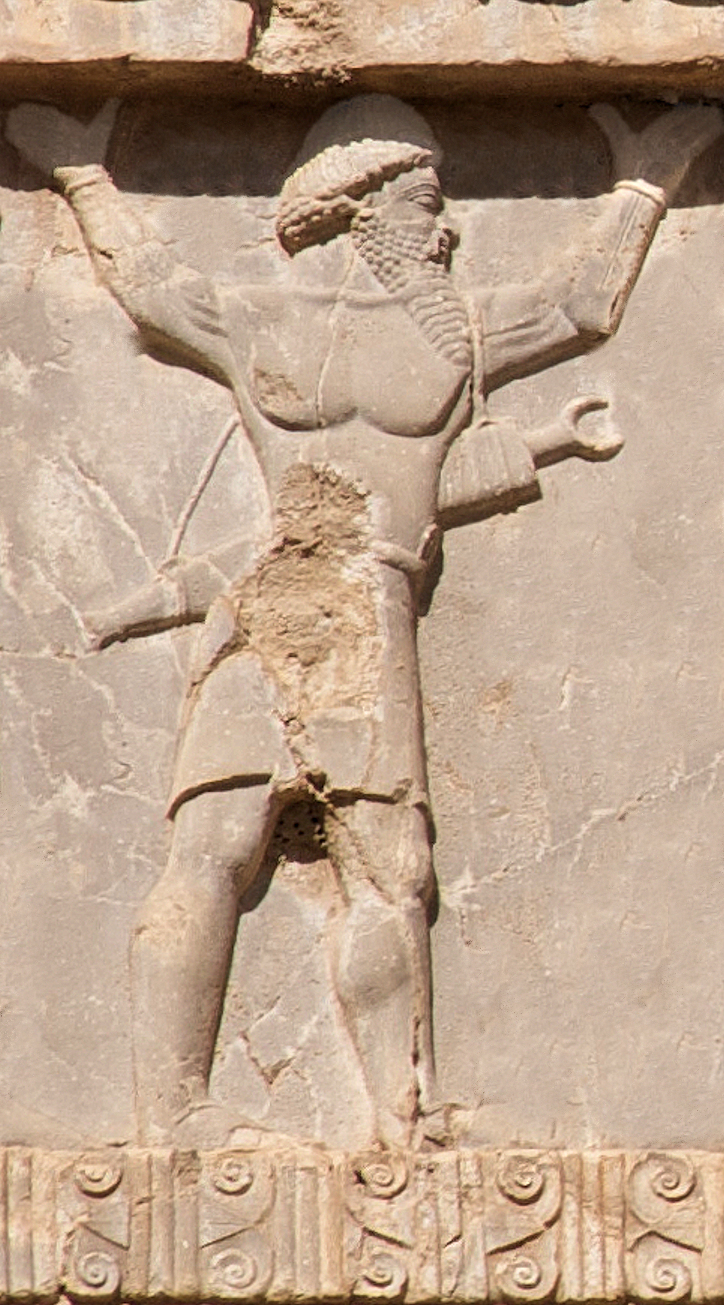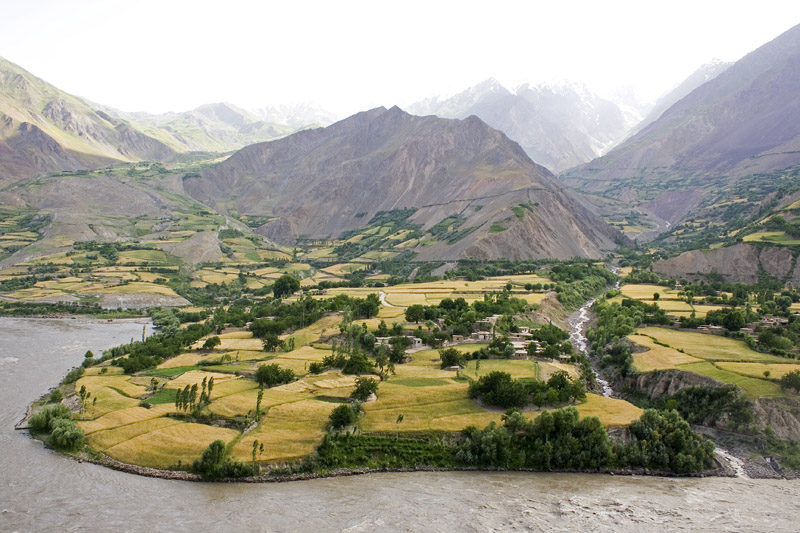|
Andarab
Andarab is the name of a large stream in Afghanistan and of the valley it empties into. The stream which originates in the Hindu Kush, near Khawak Pass, and flows to the west for about 75 miles before merging into the Surkhab. Andarab valley Together, the two streams form a long, narrow valley. The upper part of that valley is also called Andarab, the lower part alternately as Khinjan or Doshi. Both parts of the valley had been united governmentally under a single leader, or hakim, who lived at Bannu. The climate in the two parts of the valley varies considerably. Khinjan and Doshi have comparatively mild winters, while Andarab's winter is rather severe. However, Andarab stays comparatively cooler during the summer, though it gets quite hot in Khinjan and Doshi. At the turn of the 20th century, it was estimated that there were about 2,600 families living in the Andarab valley and the latest population statistics are not available. At that time, it was estimated that the Andar ... [...More Info...] [...Related Items...] OR: [Wikipedia] [Google] [Baidu] |
Khawak Pass
Khawak Pass (elevation ) sits across the route heading to the northwest from near the head of the Panjshir Valley through the Hindu Kush range to northern Afghanistan via Andarab and Baghlan. This is the route traditionally thought to have been followed by Alexander the Great in the spring of 329 BCE when he led his army from the Kabul Valley across the mountains to Bactria (later Tokharistan in the north). Vincent Smith states that Alexander took his troops across both the Khāwak and the Kaoshān or Kushan Pass. According to some scholars, there is no proof of this. The Khāwak is most probably the pass used by the famous Chinese Buddhist pilgrim monk, Xuanzang, on his return from India to China in the early-7th century. In 1333 Ibn Battuta crossed the pass on his journey to India. When dictating his account over twenty years later he remembered spreading felt cloth in front of his camels to prevent them sinking into the snow. It was also crossed by Timur (Tamerlane or Timu ... [...More Info...] [...Related Items...] OR: [Wikipedia] [Google] [Baidu] |
Kunduz River
The Kunduz River ( ps, د کندز سیند; fa, رود قندوز) is a tributary of the Amu Darya in northern Afghanistan. It rises in Bamyan Province in the Hindu Kush, and in its upper reaches is also known as the Bamyan River or the Surkhab River. After passing through Baghlan Province and Kunduz Province, the Kunduz River merges into the Amu Darya. Course The Kunduz rises in the glacier region on the north side of the Koh-i-Baba range in Bamyan Province, some 20 km south west of the town of Bamyan, where the river is known as the Bamyan River. It flows east in a deep valley separating the western part of the Hindu Kush on the north from the Koh-i-Baba on the south. After about 50 km, it bends sharp north, crossing the Hindu Kush range. It then turns northeast and enters Baghlan Province. There the river is known as the Surkhab. It then parallels a northern spur of the Hindu Kush for more than 80 km, receiving many small tributaries on its right bank. At t ... [...More Info...] [...Related Items...] OR: [Wikipedia] [Google] [Baidu] |
Hindu Kush
The Hindu Kush is an mountain range in Central and South Asia to the west of the Himalayas. It stretches from central and western Afghanistan, Quote: "The Hindu Kush mountains run along the Afghan border with the North-West Frontier Province of Pakistan". into northwestern Pakistan and far southeastern Tajikistan. The range forms the western section of the ''Hindu Kush Himalayan Region'' (''HKH''); to the north, near its northeastern end, the Hindu Kush buttresses the Pamir Mountains near the point where the borders of China, Pakistan and Afghanistan meet, after which it runs southwest through Pakistan and into Afghanistan near their border. The eastern end of the Hindu Kush in the north merges with the Karakoram Range.Karakoram Range: MOUNTAINS, ASIA Encyclopædia Britannica Towards its s ... [...More Info...] [...Related Items...] OR: [Wikipedia] [Google] [Baidu] |
Graz, Austria
Graz (; sl, Gradec) is the capital city of the Austrian state of Styria and second-largest city in Austria after Vienna. As of 1 January 2021, it had a population of 331,562 (294,236 of whom had principal-residence status). In 2018, the population of the Graz larger urban zone (LUZ) stood at 652,654, based on principal-residence status. Graz is known as a college and university city, with four colleges and four universities. Combined, the city is home to more than 60,000 students. Its historic centre ('' Altstadt'') is one of the best-preserved city centres in Central Europe. In 1999, the city's historic centre was added to the UNESCO list of World Heritage Sites and in 2010 the designation was expanded to include Eggenberg Palace (german: Schloss Eggenberg) on the western edge of the city. Graz was designated the Cultural Capital of Europe in 2003 and became a City of Culinary Delights in 2008. Etymology The name of the city, Graz, formerly spelled Gratz, most likely stems ... [...More Info...] [...Related Items...] OR: [Wikipedia] [Google] [Baidu] |
Khinjan
Khinjan District (pop: 29,600) is located in the southern part of Baghlan province in the Hindu Kush mountains. The capital is the town of Khenjan. The main Kabul-Kunduz highway passes through the district from south to west. Ethnic Tajiks makes up around 85% of the total population while the Pashtuns, Hazara and Uzbeks, each at 5%, makes up the remaining 15% of the population. See also * Districts of Afghanistan * Baghlan Province References External links MapDistrict profileby the UNHCR The United Nations High Commissioner for Refugees (UNHCR) is a United Nations agency mandated to aid and protect refugees, forcibly displaced communities, and stateless people, and to assist in their voluntary repatriation, local integrat ... (9 April 2002) Districts of Baghlan Province {{Baghlan-geo-stub ... [...More Info...] [...Related Items...] OR: [Wikipedia] [Google] [Baidu] |
Hakim (title)
and are two Arabic titles derived from the same triliteral root Ḥ-K-M "appoint, choose, judge". Hakīm () This title is one of the 99 Names of God in Islam. Hakīm (alternative transcription Hakeem) indicates a "wise man" or "physician", or in general, a practitioner of herbal medicine, especially of Unani and Islamic medicine, like Hakim Ajmal Khan, Hakim Said, Hakim Syed Zillur Rahman, etc. Hakīm or Hakeem ( ur, , hi, हकीम) is also used for practitioner of Eastern medicine, those versed in indigenous system of medicines. Hakīm was also used more generally during the Islamic Golden Age to refer to polymath scholars who were knowledgeable in religion, medicine, the sciences, and Islamic philosophy. Some examples of hakīm are: * Ibn Sina * Omar Khayyam Uses * In old Abyssinia or Ethiopia, ''Hakim'' usually meant a learned person, usually a physician. Hence a ''Hakim-Bejt'' was a doctor's house or hospital. * In Bangladesh, India and Pakistan, ''Hakim'' or ... [...More Info...] [...Related Items...] OR: [Wikipedia] [Google] [Baidu] |
Bannu
Bannu ( ps, بنو, translit=banū ; ur, , translit=bannū̃, ) is a city located on the Kurram River in southern Khyber Pakhtunkhwa, Pakistan. It is the capital of Bannu Division. Bannu's residents are primarily members of the Banuchi tribe and speak Banuchi (Baniswola) dialect of Pashto which is similar to the distinct Waziristani dialect. Total 5 Tehsil in Bannu. The major industries of Bannu are cloth weaving, sugar mills and the manufacturing of cotton fabrics, machinery and equipment. It is famous for its weekly ''Jumma'' fair. The district forms a basin drained by the Kurram and Gambila (or Tochi) rivers. Etymology According to the philologist Michael Witzel, the city was originally known in Avestan as ''Varəna'', from which its modern name derives. The ancient Sanskrit grammarian, Pāṇini, recorded its name as ''Varṇu''. During the 6th century BCE, the basin around Bannu was known as ''Sattagydia'' ( Old Persian: 𐎰𐎫𐎦𐎢𐏁 ''Thataguš'', country of ... [...More Info...] [...Related Items...] OR: [Wikipedia] [Google] [Baidu] |
Maund
The maund (), mun or mann (Bengali: ; Urdu: ) is the anglicized name for a traditional unit of mass used in British India, and also in Afghanistan, Persia, and Arabia:. the same unit in the Mughal Empire was sometimes written as ''mann'' or ''mun'' in English, while the equivalent unit in the Ottoman Empire and Central Asia was called the '' batman''. At different times, and in different South Asian localities, the mass of the maund has varied, from as low as 25 pounds (11 kg) to as high as 160 pounds (72½ kg): even greater variation is seen in Persia and Arabia... History In British India, the maund was first standardized in the Bengal Presidency in 1833, where it was set equal to 100 Troy pounds (82.28 lbs. av.). This standard spread throughout the British Raj.. After the independence of India and Pakistan, the definition formed the basis for metrication, one maund becoming exactly 37.3242 kilograms.. A similar metric definition is used in ... [...More Info...] [...Related Items...] OR: [Wikipedia] [Google] [Baidu] |
Rivers Of Afghanistan
A river is a natural flowing watercourse, usually freshwater, flowing towards an ocean, sea, lake or another river. In some cases, a river flows into the ground and becomes dry at the end of its course without reaching another body of water. Small rivers can be referred to using names such as creek, brook, rivulet, and rill. There are no official definitions for the generic term river as applied to geographic features, although in some countries or communities a stream is defined by its size. Many names for small rivers are specific to geographic location; examples are "run" in some parts of the United States, "burn" in Scotland and northeast England, and "beck" in northern England. Sometimes a river is defined as being larger than a creek, but not always: the language is vague. Rivers are part of the water cycle. Water generally collects in a river from precipitation through a drainage basin from surface runoff and other sources such as groundwater recharge, springs, a ... [...More Info...] [...Related Items...] OR: [Wikipedia] [Google] [Baidu] |
Valleys Of Afghanistan
As a mountainous country, Afghanistan contains countless notable valleys. The majority of the valleys are located in parts of northeastern, central, southern and southeastern Afghanistan. The southeastern areas are wetter and are covered by forest with trees such as cypress, oak, poplar, pine etc. Northern Hindu Kush mountain valleys Wakhan valleys include Sheghnan, Ashava, Darwaz, Drayem, Arsj, Hnjab, Farkhar, Ishkamish District valley, Khost i Fereng, Samandan, Andrab, Khenjan, Tala wa Barfak. Southern Hindu Kush valleys Panj Valley, Korm, Panjdarh Nijrab, Bandavol, Eshpi, Shishil, Kepchaq, Chardeh, Sayghan, Kahmard, Salang, Darzab, Panjshir, Ghorband District, Surobi, etc. Koh-i-Baba mountain valleys Koh-i-Baba is located in central Afghanistan and contains the valleys of Koladi, Bamiyan, Kakrak, Turkman and others. Safēd Kōh mountain valleys Valleys include Khyber Pass, Nazyan District, Shinwar District, Achen, Zarmast, Jajy, Khogyani, Kjah, Nakrokh ... [...More Info...] [...Related Items...] OR: [Wikipedia] [Google] [Baidu] |



.jpg)

